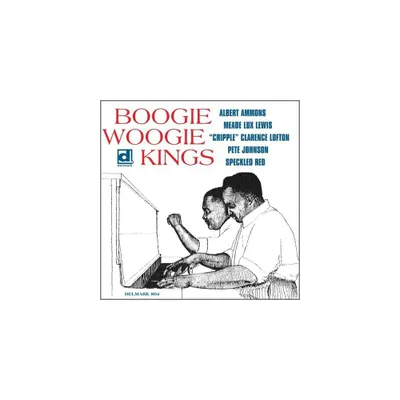Home
Boogie Woogie Kings
Loading Inventory...
Barnes and Noble
Boogie Woogie Kings
Current price: $16.99


Barnes and Noble
Boogie Woogie Kings
Current price: $16.99
Loading Inventory...
Size: OS
*Product Information may vary - to confirm product availability, pricing, and additional information please contact Barnes and Noble
Someone who has a limited knowledge of the acoustic piano styles of the '20s, '30s, and '40s might assume that stride piano (as in
James P. Johnson
,
Fats Waller
Willie "The Lion" Smith
, and
Luckey Roberts
) and boogie-woogie were the same thing. But despite being closely related, they were two different styles. Stride was very much a part of classic jazz, whereas boogie-woogie -- although certainly influenced by jazz and ragtime -- was a groove-oriented, emotionally direct form of piano blues. Some big bands and small groups played boogie-woogie, but unaccompanied solo pianists were the heart of the style. And the crucial role that the acoustic piano played in boogie-woogie is evident on
Boogie Woogie Kings
, a compilation that
Bob Koester
thoughtfully assembled for his
Delmark
label in 2009. The 19 recordings on this 53-minute CD (five of them previously unreleased) come from the
Euphonic Sounds
catalog, which
acquired -- and boogie-woogie's big three (
Meade "Lux" Lewis
Albert Ammons
Pete Johnson
) are heard on 1939 broadcasts from
the Sherman Hotel
in Chicago. Another boogie-woogie great, pianist/singer
"Cripple" Clarence Lofton
, is heard in 1938 and 1939, but performances by other contributors to boogie-woogie piano were recorded in 1960 (
Henry Brown
) or 1955 and 1971 (
Speckled Red
). Of course, a lot of things changed musically between the late '30s and the '60s and '70s. Rock & roll exploded in the mid-'50s, and boogie-woogie (like jump blues) helped pave the way for the rock & roll explosion. Hearing
Ammons
Johnson
Lewis
Lofton
playing their hearts out in the late '30s, it isn't hard to see how much their infectious, hard-driving pianism benefited early rock & roll icons such as
Little Richard
and
Jerry Lee Lewis
. Some collectors will no doubt complain about a typo in the disc's list of recording dates (track 19, the final track, is identified as track 23, even though there is no track 23). Regardless, this is an excellent compilation that boogie-woogie enthusiasts will be delighted to get their hands on.
James P. Johnson
,
Fats Waller
Willie "The Lion" Smith
, and
Luckey Roberts
) and boogie-woogie were the same thing. But despite being closely related, they were two different styles. Stride was very much a part of classic jazz, whereas boogie-woogie -- although certainly influenced by jazz and ragtime -- was a groove-oriented, emotionally direct form of piano blues. Some big bands and small groups played boogie-woogie, but unaccompanied solo pianists were the heart of the style. And the crucial role that the acoustic piano played in boogie-woogie is evident on
Boogie Woogie Kings
, a compilation that
Bob Koester
thoughtfully assembled for his
Delmark
label in 2009. The 19 recordings on this 53-minute CD (five of them previously unreleased) come from the
Euphonic Sounds
catalog, which
acquired -- and boogie-woogie's big three (
Meade "Lux" Lewis
Albert Ammons
Pete Johnson
) are heard on 1939 broadcasts from
the Sherman Hotel
in Chicago. Another boogie-woogie great, pianist/singer
"Cripple" Clarence Lofton
, is heard in 1938 and 1939, but performances by other contributors to boogie-woogie piano were recorded in 1960 (
Henry Brown
) or 1955 and 1971 (
Speckled Red
). Of course, a lot of things changed musically between the late '30s and the '60s and '70s. Rock & roll exploded in the mid-'50s, and boogie-woogie (like jump blues) helped pave the way for the rock & roll explosion. Hearing
Ammons
Johnson
Lewis
Lofton
playing their hearts out in the late '30s, it isn't hard to see how much their infectious, hard-driving pianism benefited early rock & roll icons such as
Little Richard
and
Jerry Lee Lewis
. Some collectors will no doubt complain about a typo in the disc's list of recording dates (track 19, the final track, is identified as track 23, even though there is no track 23). Regardless, this is an excellent compilation that boogie-woogie enthusiasts will be delighted to get their hands on.


![Boogie Woogie [Blu-ray]](https://prodimage.images-bn.com/pimages/0030306185491_p0_v3_s600x595.jpg)















